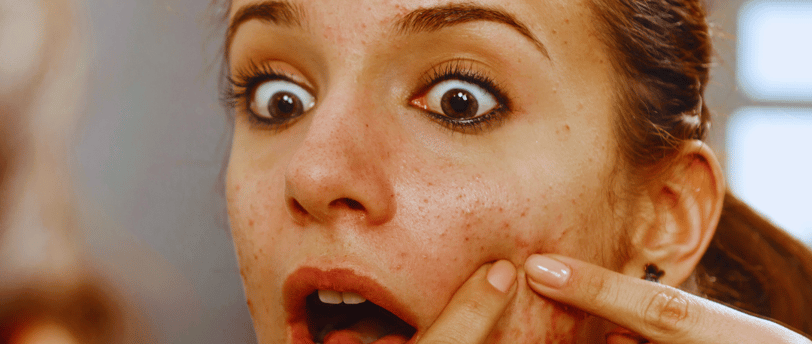How Pimples Form: Step-by-Step Explanation
Ever wondered why pimples appear on your skin? This detailed yet simple blog breaks down the process step by step, from excess oil production to clogged pores and bacteria buildup. Learn why pimples form, what triggers them, and how to prevent and treat them effectively. With practical tips and easy-to-understand explanations, you’ll gain the knowledge you need to manage breakouts and keep your skin clear and healthy.
SKINCARE
12/22/20243 min read


Pimples are a common skin problem that almost everyone experiences at some point. But have you ever wondered why they pop up in the first place? Understanding how pimples form can help you take better care of your skin and even prevent them.
In this blog, we’ll break down the process of pimple formation step by step in the simplest way possible. By the end, you’ll not only know why pimples occur but also what you can do to avoid or treat them effectively.
Step 1: Your Skin Produces Oil (Sebum)
Your skin has tiny holes called pores. Each pore is connected to an oil gland located beneath your skin. These glands produce a natural oil called sebum, which keeps your skin hydrated and protected.
Sebum is essential for healthy skin, but sometimes your body produces too much of it. This excess oil can make your skin feel greasy and clog your pores.
Why Does This Happen?
Hormonal changes (like during puberty, periods, or pregnancy).
Stress, which can increase oil production.
Genetics, meaning some people naturally produce more oil than others.
Step 2: Dead Skin Cells Block Your Pores
Your skin is constantly shedding old, dead cells to make way for new ones. Normally, these dead skin cells rise to the surface of your skin and fall off naturally.
However, when you have too much oil on your skin, it can mix with these dead skin cells and create a sticky mixture. This mixture can block your pores.
Blocked pores act like a trap, preventing oil from escaping the skin surface.
Step 3: Bacteria Invade the Blocked Pores
Your skin is home to many harmless bacteria, including a type called Cutibacterium acnes (or C. acnes). This bacteria lives on your skin without causing problems most of the time.
But when a pore gets clogged with oil and dead skin, it creates the perfect environment for bacteria to thrive. The bacteria feed on the trapped oil and multiply inside the pore.
As the bacteria grow, your body recognizes them as a threat and sends in immune cells to fight them off.
Step 4: Inflammation and Redness Occur
When your immune system detects bacteria inside a clogged pore, it triggers an inflammatory response. This is your body’s way of fighting the bacteria.
The inflammation causes the pore to swell, become red, and sometimes painful. This is how you get a classic pimple!
There are different types of pimples, depending on how severe the inflammation is:
Whiteheads: Closed, clogged pores with a white tip.
Blackheads: Open, clogged pores that appear dark due to oxidation.
Papules: Small, red bumps caused by mild inflammation.
Pustules: Pimples with pus at the top (these are the ones most people are tempted to pop!).
Cysts: Large, deep, painful pimples caused by severe inflammation.
Why Do Some People Get More Pimples?
Not everyone gets pimples in the same way. Several factors can increase the likelihood of breakouts:
Hormones:
Hormonal changes during puberty, menstruation, or stress can increase oil production, leading to more clogged pores.Diet:
Some studies suggest that sugary foods, dairy, and high-glycemic diets can trigger breakouts in some people.Skin Care Products:
Using heavy or greasy products can clog pores. Always look for products labeled “non-comedogenic” (won’t clog pores).Hygiene:
Touching your face frequently, not washing off makeup, or using dirty pillowcases can introduce more bacteria to your skin.Genetics:
If your parents had acne, you’re more likely to have it too.
Can Pimples Be Prevented?
While it’s not always possible to prevent pimples completely, there are steps you can take to reduce their frequency and severity:
Cleanse Your Face Daily:
Wash your face twice a day with a gentle cleanser to remove excess oil, dirt, and bacteria.Exfoliate Weekly:
Use a mild exfoliator once or twice a week to remove dead skin cells and prevent clogged pores.Use the Right Products:
Look for oil-free, non-comedogenic skincare and makeup products.
Incorporate ingredients like salicylic acid, benzoyl peroxide, or tea tree oil into your routine if you’re prone to pimples.
Avoid Touching Your Face:
Your hands carry bacteria and dirt that can worsen pimples.Stay Hydrated:
Drinking plenty of water helps keep your skin healthy and balanced.Manage Stress:
Stress can increase oil production and worsen acne. Practice relaxation techniques like yoga, meditation, or deep breathing.
What to Do When a Pimple Appears
If you notice a pimple forming, here’s how to handle it:
Don’t Pop It: Popping pimples can push bacteria deeper into the skin, leading to more inflammation and scarring.
Apply a Spot Treatment: Use a product with salicylic acid or benzoyl peroxide to reduce redness and swelling.
Use a Cold Compress: If the pimple is painful, apply a cold compress to reduce inflammation.
For severe or persistent acne, it’s best to consult a dermatologist who can recommend treatments like prescription creams or medications.
Key Takeaways
Pimples form when oil, dead skin, and bacteria combine to clog your pores. This leads to inflammation and the appearance of red, swollen bumps on your skin. While everyone’s skin is different, understanding how pimples form can help you take better care of your skin and reduce breakouts.
By maintaining a good skincare routine, using the right products, and managing triggers like stress and diet, you can keep your skin clear and healthy. Remember, patience and consistency are key!
Explore
Discover tips for skincare, bodycare, and haircare.
Contact-
© 2024. All rights reserved.
